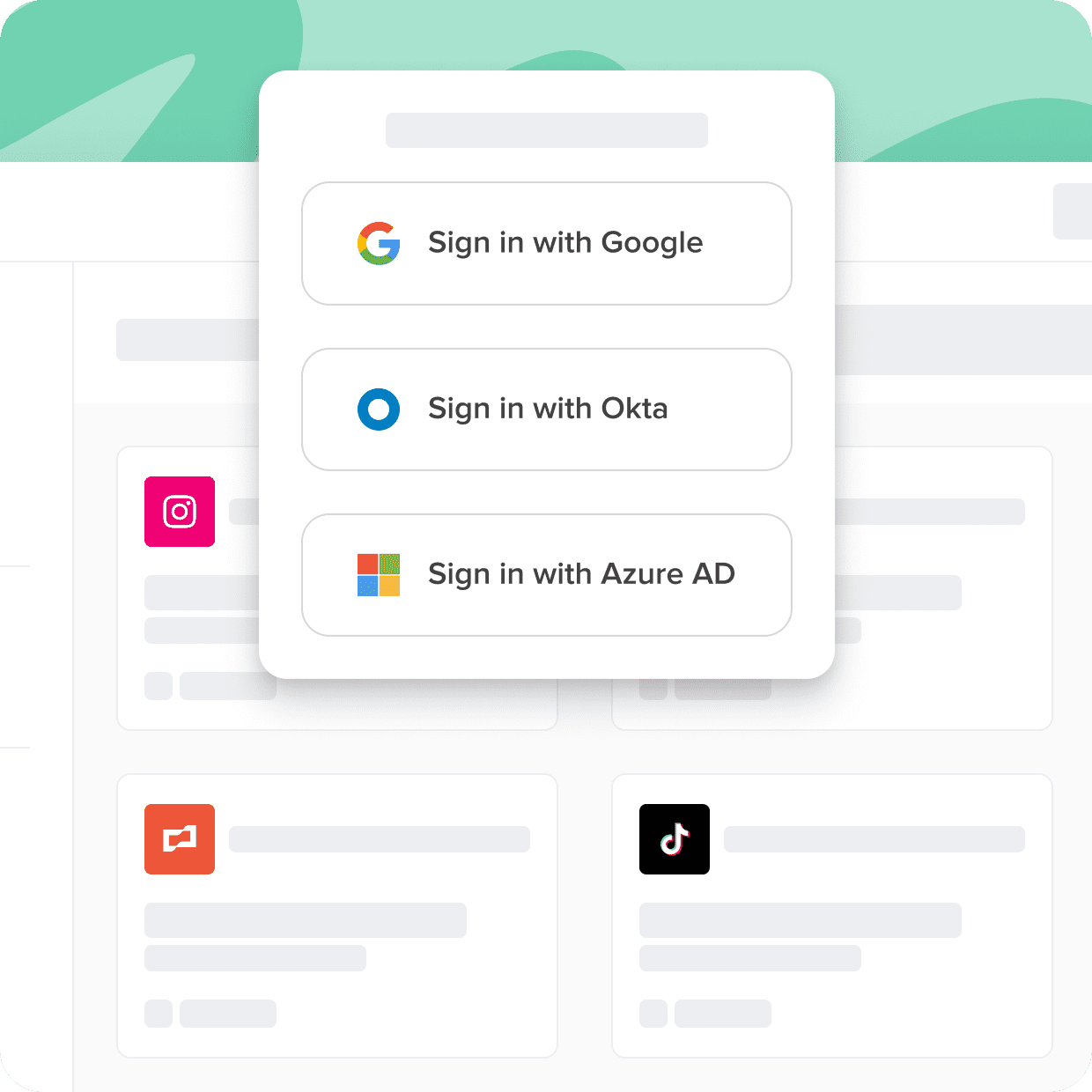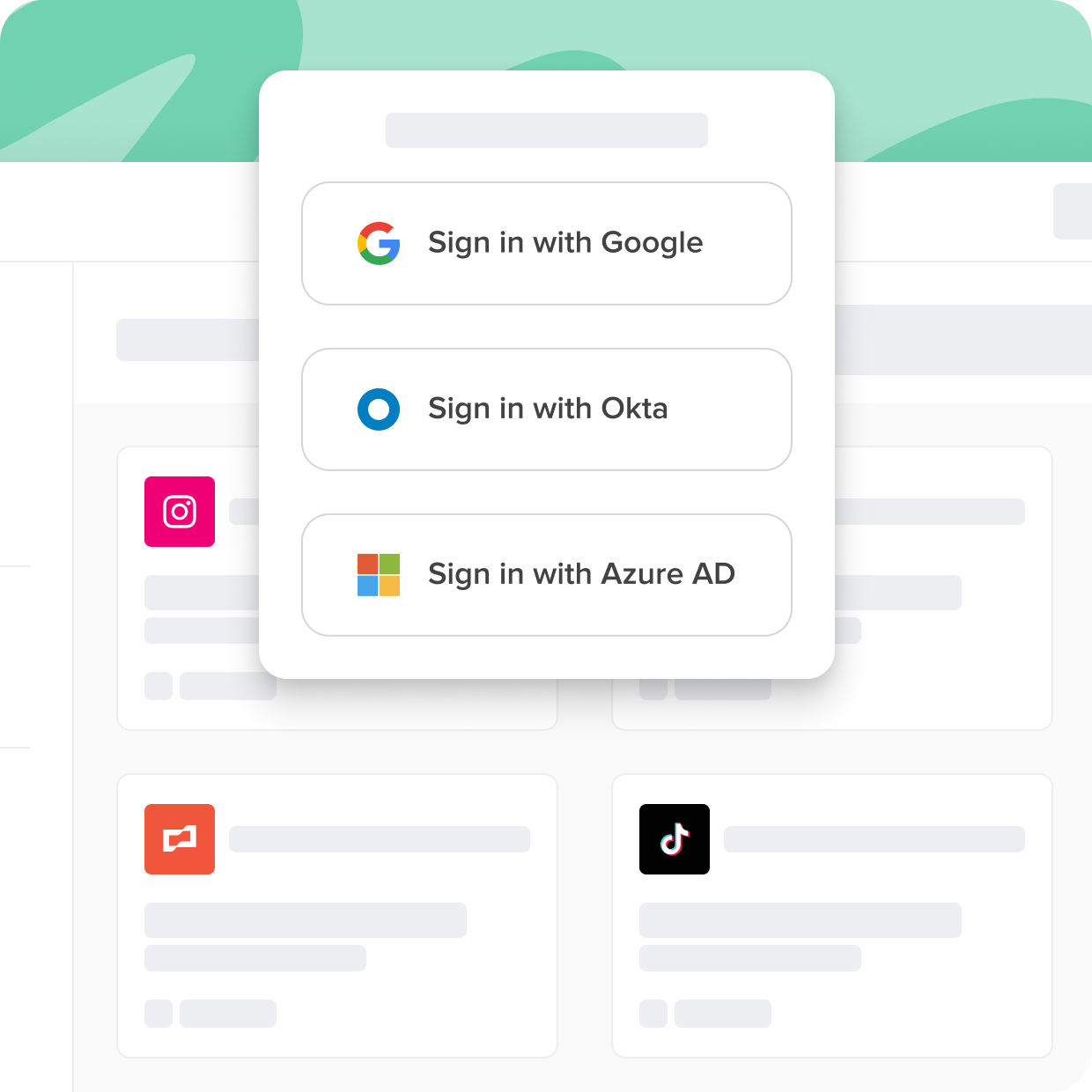Udemy SSO is a service provided by Udemy that allows businesses to enable their employees to access Udemy courses using their business credentials. Unfortunately, many corporate applications don't support the SSO standard and can't reap all the benefits. The applications that fall into this category are best called "nonfederated." Nonfederated applications are a new category that is becoming increasingly challenging for businesses to manage and secure effectively, yet increasingly critical for businesses to succeed.
Cerby connects all of your apps to your SSO tools, even if they don't support the SSO standard. In this guide, you'll learn about SSO software, the history, and the benefits.
Streamline Access With Single Sign-On
Not all apps are created equal. Some come with security gaps and complexities that can hinder user adoption and put sensitive data at risk. With Cerby, you can ensure secure and seamless access to all your applications, regardless of their support for standards like SSO.
With Cerby You Can

Close the identity gap

Universally enforce 2FA

Eliminate the SSO tax
Udemy SSO Login
SSO, or single sign-on, refers to systems that grant users the ability to use multiple programs or systems with a single set of login credentials. Udemy SSO is a service provided by Udemy that allows businesses to enable their employees to access Udemy courses using their business credentials. Instead of having employees create a separate Udemy login, they can use the same credentials they use to access their other work applications and systems. This can improve security by reducing the number of passwords employees must remember and help ensure that sensitive business information is not accessed by unauthorized individuals. It can create greater training efficiencies by saving time for IT departments that would otherwise need to manage multiple user accounts.
Another potential benefit of using Udemy SSO login is an improved user experience. Streamlining the login process means that employees need only to remember one set of credentials, making training more accessible and convenient. This may be particularly helpful for busy professionals who may not have the time or energy to create and manage multiple accounts.
Setting up Udemy SSO login involves several steps. The first step is to ensure that your company has a valid business account with Udemy. Once you have this, you’ll need to create and configure the SSO settings on the Udemy platform, which will involve selecting the type of SSO protocol to use, such as SAML.
Next, you’ll need to create and configure the SSO domains. These are the domain names that your employees will use to access Udemy courses. Finally, thorough testing of the SSO configuration will be required to ensure all configurations have been set up correctly.
Udemy SSO login is a powerful tool for businesses that use Udemy to train their employees. The potential benefits of streamlined login experiences, improved user experience, and increased security are significant, making it likely well worth the time and effort required to set up. However, a major challenge is that many applications don’t support the necessary security standards to work with SSO—namely, SAML. Nonfederated applications are a serious security risk, and research from the Ponemon Institute found that they make up a statistically significant percentage of breaches
Udemy SSO Configuration And Setup
A Udemy certificate can be highly enriching, and organizations can help employees achieve them through Udemy SSO, but before setting up Udemy Login, there are a few prerequisites that you’ll likely need to check off.
To start, you’ll need to have an active Udemy account, either as an individual or as a company team using Udemy Business. If you don't already have an account, you’ll need to sign up for one. Fortunately, Udemy sign-up is relatively simple; it will involve providing some basic information, such as your email address, and choosing a strong password that meets the Udemy password requirements.
Next, to set up a Udemy Business Login app or configure SSO for your Udemy account, you’ll need to have administrative access to your organization's domain or website. This will typically require you to have administrative or domain owner credentials since you will be required to update your domain's DNS settings and add the necessary CNAME records and TXT records in order to authenticate your login credentials.
Setting up Udemy Business SSO login can seem daunting, but with the right approach, users can quickly start accessing Udemy's vast repository of learning content. Here's a step-by-step guide to setting up Udemy SSO login:
For Udemy SSO configuration, you’ll also need to have a valid SSL certificate for your domain to ensure secure communication and data transfer. An SSL certificate is a digital certificate that verifies the identity of your domain and encrypts all data exchanged between your domain and Udemy during the login or authentication process.
You will also need to create a new SSO app within your Udemy Business account, upload your SSL certificate, and configure the app's settings and permissions to match your organization's needs.
- Create a SAML integration: To start, users must create a SAML (Security Assertion Markup Language) integration within their Udemy account. This can be done by logging into the account and navigating to the SSO/SSO SAML tab, then selecting 'add new integration'. Choose 'SAML' and name the integration.
- Configure SSO settings: Next, users will be asked to configure SSO settings. This will include the creation of a public and private key pair to use in signing data, as well as the input of the SSO URL and entity ID from the identity provider.
- Create and configure SSO domains: Users need to create and configure SSO domains to grant access to the Udemy app via SSO. These domains must be added in the 'Domains' tab in the Udemy account settings, with the name and redirect URL.
- Test SSO configuration: Once all the SSO settings have been configured, it's time to test it. The simplest method is to use an incognito tab in the browser and navigate to the Udemy SSO login in the app. Upon attempting to log in, users will be redirected to the identity provider's login page, then back to the Udemy app once authenticated. Fortunately, setting up Udemy SSO SAML is achievable with the right steps.
It's important to create and configure SSO settings properly, as well as to set up domains and test the configuration to ensure everything is working as expected.
Udemy SSO Integration With Identity Providers
Udemy SSO integration with identity providers can enable businesses to grant their employees access to courses and learning material through their existing Enterprise application user identity. This integration reduces the need for multiple logins and can even improve the overall security of your personnel's data. Integrating Udemy SSO with identity providers such as Okta or Microsoft Azure AD can be a pretty seamless process.
Configuring SSO to work with Identity Providers like Okta or Microsoft Azure AD involves several steps. The first step is to log in to your Udemy for Business account as an administrator and navigate to the SAML integration page. Here, you will find all the SAML metadata information required in configuring your Identity Provider.
Once you have copied and configured the Identity Provider with the SAML information, you can authenticate your employee's credentials via an Identity Provider. Next, for Azure, you can initiate Udemy SSO Azure integration in a few steps.
Firstly, search for Udemy in the Azure enterprise applications. You can then provide your Udemy administrator credentials to complete the setup. You will find the Udemy application in the Azure portal and configure the necessary SSO settings. For Okta, integration is even simpler. Once in your Okta admin panel, go to Applications and select Add Application. Search for Udemy and then connect your Okta account with the Udemy application.
Finally, add Udemy to your employee's Okta application dashboard. Udemy SSO integration with Identity Providers like Okta and Microsoft Azure AD can also be configured via SCIM. This can be particularly helpful for large organizations using Udemy.
SCIM (System for Cross-domain Identity Management) facilitates automation of user identity management between systems, specifically between identity providers and service providers like Udemy. This allows automated provisioning and de-provisioning of user accounts, making user account management smooth.
Integrating Udemy SSO with Identity Providers like Okta or Microsoft Azure AD is a straightforward process and can significantly improve the efficiency of your employee's learning and training programs.
Udemy SSO Troubleshooting
Udemy SSO integration is a great way to streamline and simplify user authentication on your account. Still, as with any technology, it's not without its share of common issues that often arise during the setup process. Should you experience difficulties setting up your Udemy SSO login, don't panic! Here are some tips and tricks to help you troubleshoot and prevent common mistakes.
Before jumping in, it's important to note that Udemy SSO integration is only available for Udemy Business accounts. If you're using the Udemy Business login app, you're already set up for SSO and can skip ahead to troubleshooting.
If you’re sure you're using a supported account and you’re still having trouble setting up Udemy SSO, make sure to check that your browser is up-to-date and that you've enabled third-party cookies. This is a common mistake that can prevent SSO from working properly. Additionally, if you're experiencing issues with your SSO login, try clearing your web browser’s cache and cookies. This can help refresh the connection between your browser and Udemy's servers, making it easier to authenticate your identity. Finally, if you're still experiencing issues after trying these troubleshooting methods, contact Udemy support for more assistance. They'll be able to help you diagnose the issue and get you back up and running.
To prevent common mistakes, make sure to carefully read through all documentation and instructions related to your Udemy SSO setup. Pay close attention to any prerequisites or requirements, and feel free to ask for help if you need clarification on anything. Setting up Udemy SSO integration can be a great way to simplify your user authentication and streamline your account. However, like any software, issues can arise. With these troubleshooting tips and preventative measures, you'll likely be better able to stay ahead of any problems and enjoy a seamless SSO experience.


